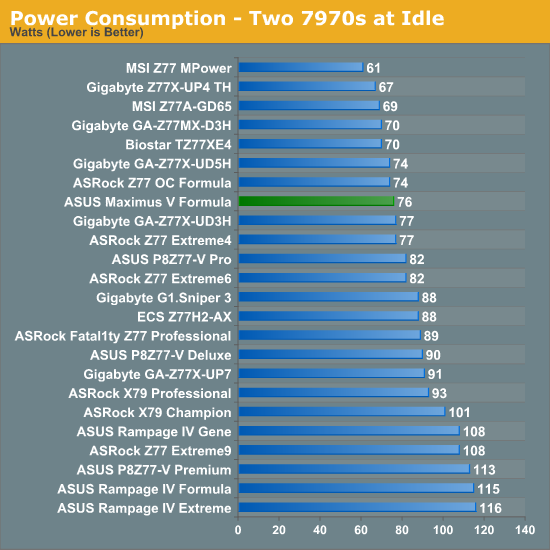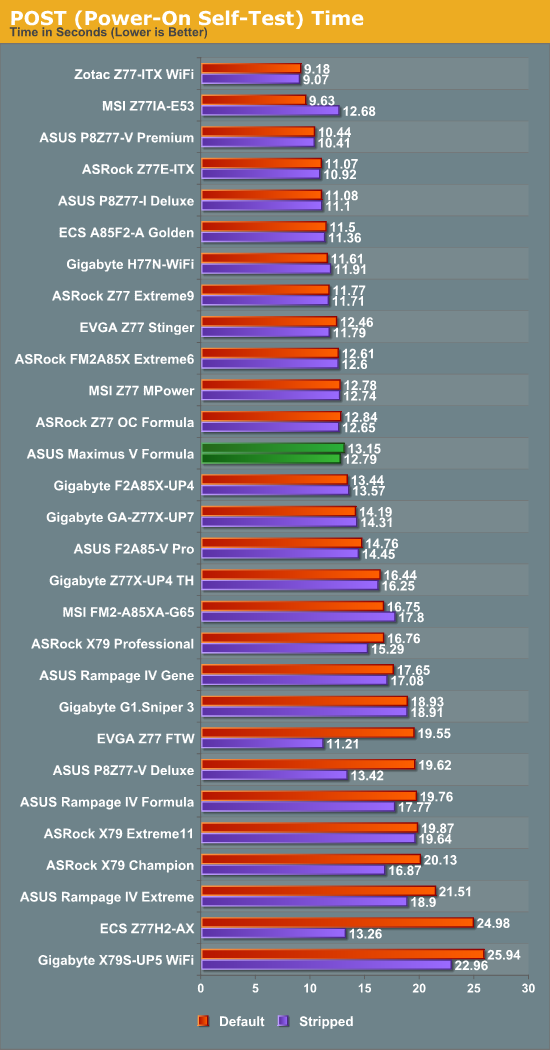ASUS Maximus V Formula Z77 ROG Review
by Ian Cutress on March 25, 2013 2:30 PM EST- Posted in
- Motherboards
- Asus
- ROG
- Z77
Many thanks to...
We must thank the following companies for kindly providing hardware for our test bed:
Thank you to OCZ for providing us with the 1250W Gold Power Supply and USB testing SSD.
Thank you to G.Skill for providing us with the memory kits.
Thank you to ASUS for providing us with the AMD GPUs and some IO Testing kit.
Thank you to ECS for providing us with the NVIDIA GPUs.
Test Setup
Power Consumption
Power consumption was tested on the system as a whole with a wall meter connected to the OCZ 1250W power supply, while in a dual 7970 GPU configuration. This power supply is Gold rated, and as I am in the UK on a 230-240 V supply, leads to ~75% efficiency > 50W, and 90%+ efficiency at 250W, which is suitable for both idle and multi-GPU loading. This method of power reading allows us to compare the power management of the UEFI and the board to supply components with power under load, and includes typical PSU losses due to efficiency. These are the real world values that consumers may expect from a typical system (minus the monitor) using this motherboard.
While this method for power measurement may not be ideal, and you feel these numbers are not representative due to the high wattage power supply being used (we use the same PSU to remain consistent over a series of reviews, and the fact that some boards on our test bed get tested with three or four high powered GPUs), the important point to take away is the relationship between the numbers. These boards are all under the same conditions, and thus the differences between them should be easy to spot.

Out of the OC motherboards we have tested, the MSI Z77 MPower and ASRock Z77 OC Formula have been very efficient compared to almost every other board tested. The Gigabyte Z77X-UP7 came fairly low down in our power tests due to the number of power phases as well as the PLX chip onboard. The ASUS MVF follows the MSI and ASRock and stays in the top half for power consumption.
POST Time
Different motherboards have different POST sequences before an operating system is initialized. A lot of this is dependent on the board itself, and POST boot time is determined by the controllers on board (and the sequence of how those extras are organized). As part of our testing, we are now going to look at the POST Boot Time - this is the time from pressing the ON button on the computer to when Windows starts loading. (We discount Windows loading as it is highly variable given Windows specific features.) These results are subject to human error, so please allow +/- 1 second in these results.

Out of the Z77 OC boards we have tested, MSI, ASRock and ASUS all hover around the 13 second mark for Windows 7 POST with dual 7970s and the Gigabyte UP7 is a second behind.










38 Comments
View All Comments
stefan from europe - Monday, March 25, 2013 - link
Thanks Ian for the review, but imo little late when in 2 months we have z87 on the way.Razorbak86 - Monday, March 25, 2013 - link
Take it up with Asus. They just sent him the board for review. Perhaps they should have participated in the Z77 mobo round-up conducted months ago?Jambe - Monday, March 25, 2013 - link
Quite the thoroughgoing review! Alas, I don't even consider standard ATX motherboards anymore, let alone EATX monsters.Still, it was a nice read, and the photos were lovely. That VRM cooler is neat...
Razorbak86 - Monday, March 25, 2013 - link
The MVF is only 0.5" wider than ATX, and exactly the same height as ATX. For that reason, it will easily fit in most mid-tower ATX cases. Full-size E-ATX boards (e.g., some server boards) can be up to 3" wider than standard ATX width.Jambe - Tuesday, March 26, 2013 - link
Mm, yes, but as I said, I don't bother with even standard ATX motherboards or chassis these days. I'd wager that mATX can provide what the vast majority of tech DIYers and enthusiasts and I'd further say that mITX can suffice for virtually everyone else.From my perspective it's just an economy issue: if one doesn't need and won't use the space and expansion options of standard ATX (or larger) motherboards & chassis, why bother with either?
Razorbak86 - Wednesday, March 27, 2013 - link
I wasn't trying to persuade you to buy the MVF. I was just trying to negate the implication that this board is an "EATX Monster", when it is actually much closer to ATX than EATX.vvk - Monday, March 25, 2013 - link
What is the point?Maybe I am little confused but considering Haswell is expected to come in 2months what is the point of buying this or any other ivy bridge MB now? Also considering how close all MBs game scores were investing in a better GPU would yield much grater benefits, per dollar.
5150Joker - Monday, March 25, 2013 - link
For people like me that built a desktop system a month ago and didn't want to wait on Haswell.scook9 - Tuesday, March 26, 2013 - link
Long time no see 5150Joker! I concur, I am reading this since I built my desktop in October with this board (with complete confidence in Asus) and wanted to see a good AT review to validate my decision :)noeldillabough - Tuesday, March 26, 2013 - link
And there is something to be said about a tested platform over a new unproven one. Bleeding edge causes some bleeding lol.